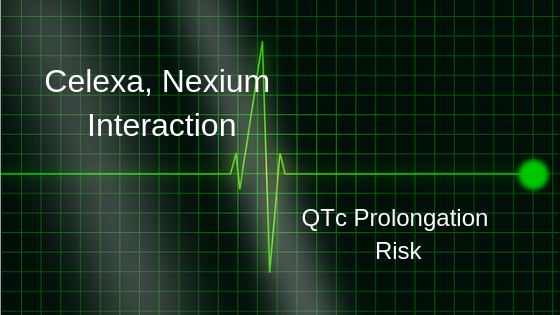The Celexa and Nexium interaction is a challenging one. As a clinical pharmacist, I don’t want to create a bunch of other work or switch agents when medication therapy is working and justified. I feel like we (physicians, NP’s, PA’s as well) often get put in this situation where there is an interaction that can cause really serious problems, but the risk for that outcome is extremely rare.
Celexa and Nexium Interaction
So how can the Celexa and Nexium Interaction affect our patients? Nexium, like
- Look at the doses of each agent. If they are both low doses, this likely isn’t a big deal.
- Look at the latest EKG. If the QTc value is solid within the normal range and they have been on Celexa and Nexium at the time the EKG was taken, there’s no reason to be highly concerned.
- Look at the other medications. If other medications are on the list that can prolong the QT interval, I may be a little more concerned. Antipsychotics (listen to the podcast), antiemetics, and some
antiarrythmics are a few examples. - Look at risk factors like electrolytes imbalances (magnesium and potassium in particular).
Action Items – Celexa and Nexium Interaction
If I felt that something needed to be done with this interaction, here’s what I would consider changing.
- Nexium would potentially be a pretty easy switch to an H2 blocker. That is probably where I would start. There may be situations where that isn’t possible.
- Switching PPI’s. Pantoprazole would be less likely than Nexium to raise concentrations of Celexa.
- Depending upon depression and effectiveness of Celexa, you could consider changing the SSRI. Sertraline would not have this interaction as it avoids CYP2C19 metabolism.
- Do an EKG. If there isn’t a recent one on record and you are concerned, this is a potential option.
I would say in the majority of situations, I’m probably going to leave this drug interaction alone. Many times, a chronic PPI isn’t necessary, so that is a great way to tackle polypharmacy and avoid the interaction. This can be challenging, however, especially if you work in a setting where access to clinical information is limited.
- 30 medication mistakes PDF
- 18+ Page Drug Interaction PDF
- 10 Commandments of Polypharmacy Webinar based on my experiences in clinical practice



0 Comments